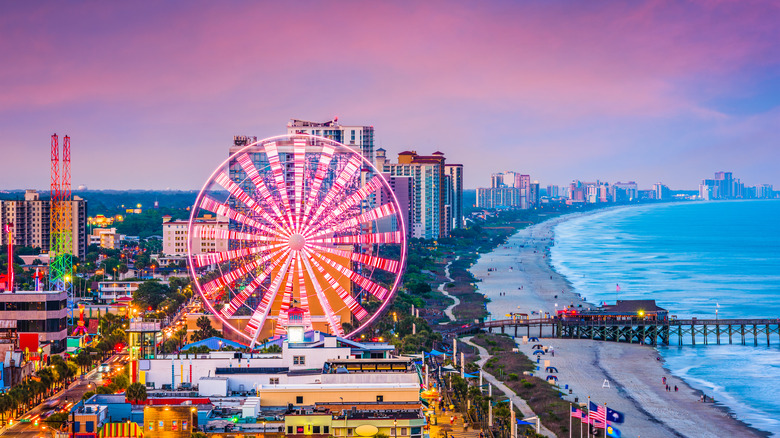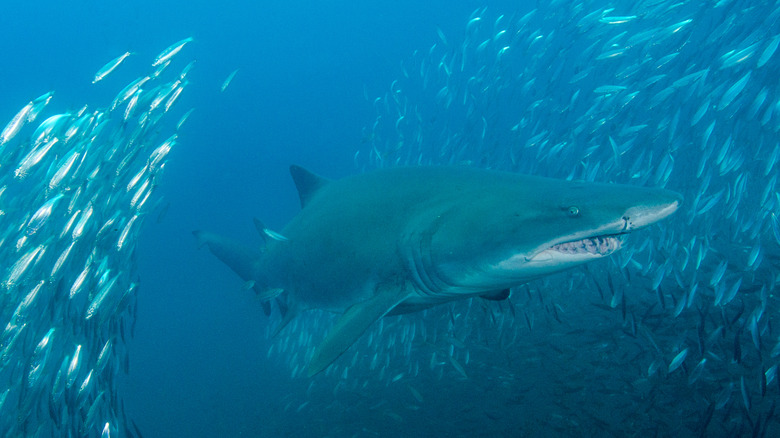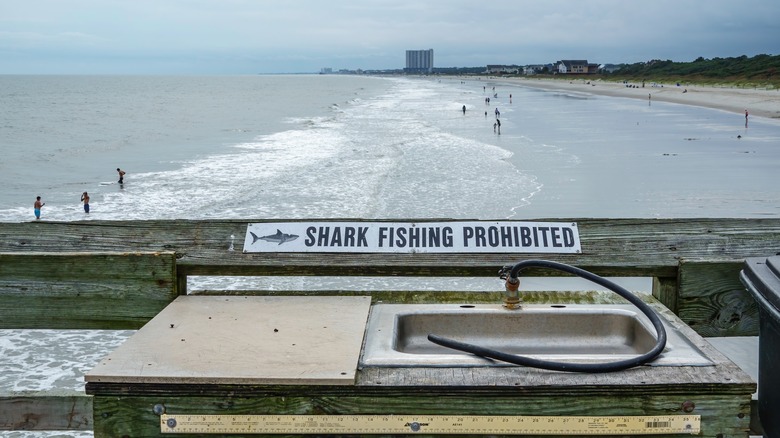You May Want To Think Twice Before Swimming At This Popular East Coast Beach
On the East Coast, Myrtle Beach is probably one of the best-known destinations for summer vacations. Whether you're planning a relaxing golfing trip, a family beach vacation, or a long weekend of revelry, Myrtle Beach attracts all types of vacationers. In fact, the area welcomes around 19 million visitors annually. Needless to say, almost all of those passengers landed on the northern coast of South Carolina to enjoy the area's beaches, wild nightlife, family-fun entertainment, and award-winning golf courses. The sharks? Probably not so much.
Myrtle Beach, as well as surrounding areas of Horry County, encompass 60 miles of coastline, which includes six main public beaches with a staggering 114 public beach access points. Aptly known as the Grand Strand, this popular coastline is undoubtedly the largest draw to Myrtle Beach. Most of those 19 million visitors head straight to the beach upon arrival (or golf courses). Do you know who else likes the Grand Strand? Sharks. The people in it? They're not too interested, but it's never a bad idea to think twice about what lurks beneath.
Myrtle Beach has a LOT of sharks
The waters around Myrtle Beach are home to around 40 different species of sharks. Some shark species live in the area year-round, while some are more like the different influx of visitors landing at the airport. Some of the scariest include the bull shark, tiger shark, and yup, the great white shark. There are a few reasons for the back-finned visitors. Annually, some migrate north to south, while some move inland and back to sea, depending on water temperature. And, yup, their migration patterns tend to follow the same migration patterns of vacationers to Myrtle Beach.
Due to the artificial reefs, inlets, and abundant sea life, sharks love the area. With so many people swimming with sharks, what could go wrong? Well, shark attacks can and do happen in Myrtle Beach and Horry County. But, according to the International Shark Attack File out of the University of Florida, the sheer amount of incidents in the area is still infinitesimal. Since 1837, there have been 35 confirmed unprovoked shark attacks in Horry County.
A few tips for swimming in the area
When you consider how many people swim off the Grand Strand each year, the low number of shark attacks is a little surprising. But, even so, there are still a few swimming tips you can follow to minimize your chances of a shark encounter. Don't swim at night, dawn, or dusk, which could lead to a case of mistaken identity. Don't wear shiny jewelry. Again, mistaken identity. Don't swim near people fishing or around piers. Chum in the water. And don't swim if you see traveling bait balls (schools of fish). Because, duh, shark food makes it way too dangerous for swimming.
And, if it makes you feel any better, sharks aren't trying to eat you. They're either confused or curious, so if they do bite you, they should release you pretty quickly. Not that it won't hurt, but again, they're not trying to eat you. We'd be amiss not to mention that Myrtle Beach did experience a few shark attacks in 2022, though they weren't life-threatening encounters. Overall, given the number of sharks, we'd understand if you'd think twice about swimming in the Myrtle Beach area. After all, there's always golf ... and alligators.


